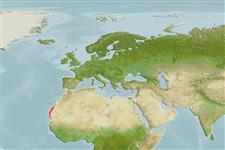Teleostei (teleosts) >
Blenniiformes (Blennies) >
Blenniidae (Combtooth blennies) > Blenniinae
Etymology: Spaniblennius: Greek, spanios, -a, -on = rare + Greek, blennios = mucus (Ref. 45335).
Environment: milieu / climate zone / depth range / distribution range
Ecology
Marine; demersal; depth range 17 - 30 m. Subtropical
Eastern Atlantic: Rio d'Oro (Mauritania/Morocco).
Size / Weight / Age
Maturity: Lm ? range ? - ? cm
Max length : 5.1 cm SL male/unsexed; (Ref. 5298)
Short description
Identification keys | Morphology | Morphometrics
Depth range of 17 - 30 meters given by Peter Wirtz (pers. comm. 05/05). Oviparous. Eggs are demersal and adhesive (Ref. 205), and are attached to the substrate via a filamentous, adhesive pad or pedestal (Ref. 94114). Larvae are planktonic, often found in shallow, coastal waters (Ref. 94114).
Life cycle and mating behavior
Maturity | Reproduction | Spawning | Eggs | Fecundity | Larvae
Oviparous, distinct pairing (Ref. 205).
Bath, H., 1990. Blenniidae. p. 905-915. In J.C. Quero, J.C. Hureau, C. Karrer, A. Post and L. Saldanha (eds.) Check-list of the fishes of the eastern tropical Atlantic (CLOFETA). JNICT, Lisbon; SEI, Paris; and UNESCO, Paris. Vol. 2. (Ref. 5298)
IUCN Red List Status (Ref. 130435: Version 2025-1)
Threat to humans
Harmless
Human uses
Tools
Special reports
Download XML
Internet sources
Estimates based on models
Preferred temperature (Ref.
123201): 18.1 - 20.6, mean 19.3 °C (based on 12 cells).
Phylogenetic diversity index (Ref.
82804): PD
50 = 0.7500 [Uniqueness, from 0.5 = low to 2.0 = high].
Bayesian length-weight: a=0.00575 (0.00253 - 0.01308), b=3.06 (2.86 - 3.26), in cm total length, based on LWR estimates for this (Sub)family-body shape (Ref.
93245).
Trophic level (Ref.
69278): 3.3 ±0.4 se; based on size and trophs of closest relatives
Resilience (Ref.
120179): High, minimum population doubling time less than 15 months (Preliminary K or Fecundity.).
Fishing Vulnerability (Ref.
59153): Low vulnerability (10 of 100).
🛈
Climate Vulnerability (Ref.
125649): High to very high vulnerability (73 of 100).
🛈
Nutrients (Ref.
124155): Calcium = 407 [203, 960] mg/100g; Iron = 1.84 [1.06, 3.62] mg/100g; Protein = 17.9 [16.9, 19.0] %; Omega3 = 0.264 [0.134, 0.514] g/100g; Selenium = 18.2 [7.5, 42.1] μg/100g; VitaminA = 25.8 [7.1, 93.4] μg/100g; Zinc = 1.9 [1.2, 2.9] mg/100g (wet weight);
